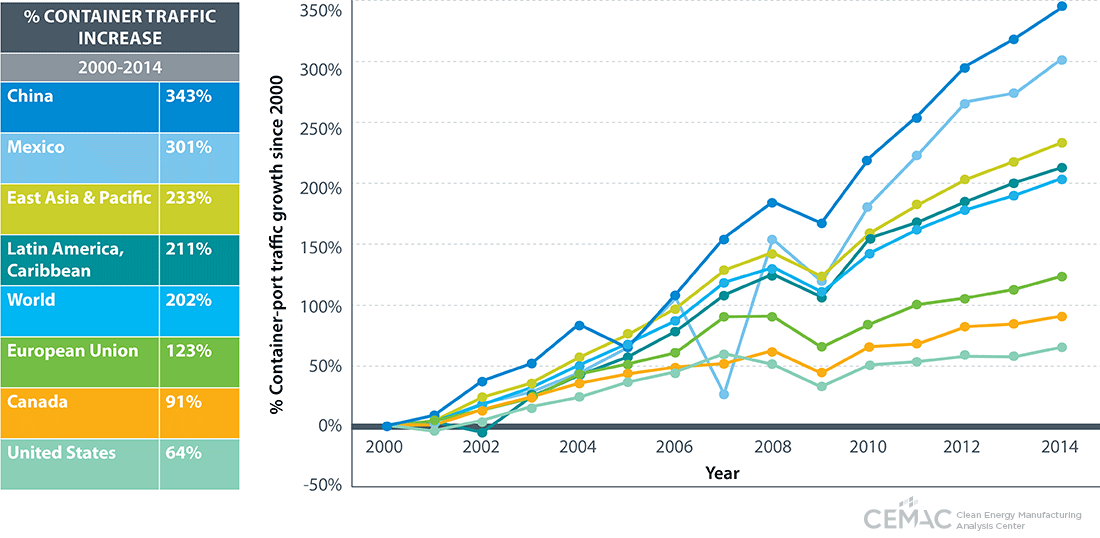Mitigating Maritime Shipping Impacts on Manufacturing Costs
August 1, 2016
By Samantha Reese, CEMAC Analyst, and Maggie Mann, CEMAC Technical Director
Manufacturing is not just making products in a single facility. It includes the complex logistics of shipping materials from processing facilities and subcomponents from a network of suppliers. The cost paid for shipping goods along the supply chain and to demand markets can also escalate due to a variety of complications. As an example, we looked specifically at delays due to shipping congestion that can result in significantly higher inventory costs and delays across the manufacturing supply chain.
With the increase in global manufacturing output, infrastructure for transporting goods between and within nations is experiencing greater congestion.i As economies have grown, increasing demand has stimulated both factory production and the shipping of cargo worldwide. The table below illustrates how from 2000 to 2014, global port congestion has increased as the improving worldwide economy has led to greater amounts of cargo being shipped.

Ports in the United States are experiencing high volumes, causing expensive inventory and fulfillment delays. ii The three-year average of on-time East-West container ship reliability has decreased over the last ten years to just over 50%. iii All of this led to changes in shipping operations that seek to maximize the use of increasingly large ships, which has pushed infrastructure to move goods into and out of key markets to capacity limits.
Increasingly large ships can further exacerbate the problem. For one, terminals built before 2000 are unable to accommodate the larger container ships of today, whose capacities have increased from 1,000 20-foot container units (TEU) in 1960 to the new 2013 Triple E Class Maersk ship that holds 18,000 TEUs. Beyond port size, the handling equipment at many North American ports cannot accommodate the increasing height of the world's largest container ships.iv
These ships, or "mega-ships," are affecting trade flows in another interesting way. The desire to fill the new mega-ships before castoff creates delays that back up into the supply chain, as companies join alliances to combine their shipments.v Increased productivity at ports has been the primary response, but cranes are quickly approaching their operating limits as vessels with capacities large enough to carry 24,000 TEUs are expected to be deployed by 2020. Massive ship capacity also results in port activity peaks, including those associated with the secondary land transport of goods from ports, resulting in logistics delays and downstream highway and rail congestion. Investments in greater port capacity are being made worldwide, but lagging in demand.
Transportation infrastructure congestion can have a deleterious effect on the manufacturing of clean energy technologies, where market competitiveness may depend on tight control of inventory and shipments across the supply chain. Transportation infrastructure limitations tend to be a greater concern for companies with longer supply chains and can result in higher inventory levels and carrying costs related to financing and warehousing.ii Further, schedule uncertainties due to weather conditions, delays in access to ports, port terminal congestion, and security concerns can lead to compounded delays across complex supply chains.i
How can these transportation limitations be mitigated? Locating manufacturing closer to suppliers and demand centers can reduce the distance and therefore potential for disruption. Tightening the supply chain for critical components, for example, taking care of administrative responsibilities when containers are loaded and sealed, can increase delivery reliability of the key inputs. These and similar techniques can reduce total manufactured cost of many clean energy technologies. At CEMAC, we include known transportation costs in our analyses, and conduct sensitivity analysis to determine the level of potential impact from transportation challenges, important factors to consider when planning manufacturing and securing supply chains.
i Rodrigue, Jean-Paul, and Theo E. Notteboom. "Containerization, Box Logistics and Global Supply Chains: The Integration of Ports and Liner Shipping Networks." In Port Management, edited by Hercules E. Haralambides, 5–28. London: Palgrave Macmillan UK, 2015. .
ii Stalk, George, and Petros Paranikas, "Is Your Supply Chain Ready for the Congestion Crisis?" BCG Perspectives, July 9, 2015.
iii Drewy, "Carrier Performance Insight 2015." August 2015. .
iv LeVine, Steve, "The Suez and Panama canals are being expanded, but some ships still won't fit into either," Quartz, August 5, 2015. .
v Leach, Peter, "Global ports grapple with congestion generated by larger ships and alliances," Journal of Commerce, August 25, 2014. .
vi The World Bank "Container Port Traffic (TEU: 20 Foot Equivalent Units) | Data." Accessed July 28, 2016. .

